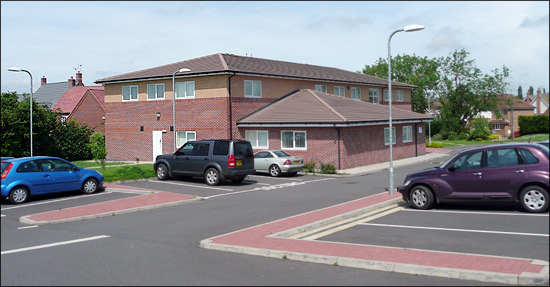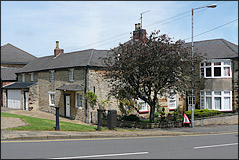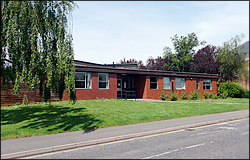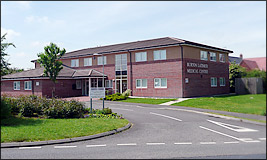|
The National Health Service was founded in 1948, and we take modern standards of health care very much for granted in terms of low cost and wide availability.
There are fewer and fewer adults alive now who can speak of the state of health provision before 1948, but the records, articles and recorded memories which exist from this and previous centuries show what the reality was for millions of people who either had little access to health care or who were so poor that they literally could not afford to be ill or injured. The story of Rose Mason is an example of how people relied upon good-hearted neighbours or relations to help out in times of need.
Before Kettering General Hospital opened in 1897 patients needing hospital care were sent to Northampton Infirmary on the recommendation of someone of influence. The records of Burton Latimer people admitted to the Infirmary between 1744 and 1827 can be found here
Burton-based official health care was not readily available until the 1890s. There were no resident doctors, and if a doctor were needed he would have to be called from Kettering.
Doctors recorded as attending patients in Burton Latimer
1860 – 1970
Information on early doctors supplied by Barrie MacKay
1860-67: James Logan (Kettering) – as Medical Officer of No:2 District, Kettering Union, attended Burton Latimer patients including accident victims on a regular basis.
1867–1906: John Lowe Price (Kettering) – Medical Officer and vaccinator of Kettering No:2 District attending accident victims and routinely visiting Burton Latimer.
1884: John Winter Dryland (Kettering) – gave evidence at inquest on Burton Latimer patient
1894: John Allison (Kettering) – physician & surgeon visiting Burton Latimer weekly
1898–1921: Herbert Burland (Finedon and Meeting Lane, Burton Latimer) – physician & surgeon, medical officer, public vaccinator, certifying factory surgeon, medical officer of the Cottage Homes.
1900–01: Hugh Norman Crowley Atkinson (Burton Latimer, Church Street) – physician and surgeon
1905–1917: Thomas Arthur Ball Harris (Burton Latimer) – physician & surgeon, medical officer, public vaccinator, certifying factory surgeon
1916–1923: Edward Crofton Byrne (Burton Latimer) – physician & surgeon, medical officer, public vaccinator, certifying factory surgeon
1923–1934: Edwin Lloyd Warner (Burton Latimer, Osborne House) – physician & surgeon, medical officer of health, public vaccinator, certifying factory surgeon (click here for information on Dr Warner)
1928: Alan Strachan (Finedon) – public vaccinator for Burton Latimer
1928–1938: Frederick Kenneth Beaumont (Finedon) – physician & surgeon, medical officer of health, public vaccinator, certifying factory surgeon (practice partner of Dr E L Warner and then Dr A P Kingsley)
1934–1972: Albert Prince Kingsley (Burton Latimer, Osborne House) – physician, surgeon, medical officer of health to the Urban District Council, certifying factory surgeon and medical officer No. 29 District Kettering Area Guardians Committee, Northamptonshire County Council (click here for memories of Dr Kingsley)
1938–early 1970s: William Andrew Godfrey Bell (Finedon) – physician & surgeon (practice partner of Dr A P Kingsley; held surgeries at Osborne House) (click here for information on Dr Bell)
1954– (retired 1990): Kenneth I Padget (Burton Latimer)
Home Office Factory Department announcements of certifying surgeon appointments and resignations to be found in London Gazette extracts online:
Dr Burland: 18.4.1901 Finedon District; 4.10.1921 vacancy created by his death
Dr Harris: 26.2.1913 Burton Latimer District; 23.8.1917 vacancy after his resignation
Dr Byrne: 5.10.1917 Burton Latimer District; 30.4.1923 vacancy after his resignation
Dr Warner: 1.6.1923 Burton Latimer District: 31.3.1934 vacancy after his resignation
Dr Strachan: 2.4.1928 Finedon District vacancy after his resignation (filled Dr Burland’s shoes in 1921–22?)
Dr Beaumont: 4.5.1928 Finedon District; 3.4.1938 vacancy after his resignation
Dr Kingsley: 18.4.1934 Burton Latimer District
Dr Bell: 1.6.1938 Finedon District
|
|
 |
|
The above advertisement appeared in the Stamford Mercury 11 April 1890 but it seems the village had to wait over a
year before the position was taken up according to the Parish Magazine extract below:
|
|
St Mary's Church Parish Magazine, August 1891
At length, the Rector and Mrs. Newman have succeeded in engaging the services of a person to act as village nurse. A few months will prove her suitability or otherwise for the work, and whether her engagements are numerous enough to make the post sufficiently remunerative. A cottage, or apartments, will be provided, rent free for Mrs. Flavell and £10 a year guaranteed. In addition to this she will receive the payments of those who employ her, according to a recognised table of fees. Donations, or subscriptions, monthly, quarterly or yearly to the "Village Nurse Fund" will be gratefully received by Miss Newman at the Rectory.
Before her appointment, the 1891 Census shows Eliza Flavell, widow, aged 58, nurse (sick), living with Mrs. Julia Green in Cranford Road. In 1901, described as a retired sick nurse, she is living in Pigott's Lane. She was buried in 1902 and her address was given as Widow's Cottages, Pigott's Lane. This was a row of cottages, belonging to the Rector. on the left at the top of the lane before the bend.
|
The following appearied in the Evening Telegraph in 1915: "Nurse Jessop, who has been three years at Burton, under the Nursing Association, has left to take up training as a Queen’s Nurse. Nurse Jessop has rendered capital service during her stay, ans the association are sorry to lose her. Her successor is Nurse Webb, who has done good work at East Ham, London. She is fully certified in midwifery, and until she can secure a house is taking up residence with Mrs. Hartup, 12 Victoria-terrace, Station-road."
The other source of emergency heath care around 1890 was St John Ambulance. Doctor Herbert Burland was based in Finedon, and ran a part-time surgery in Burton (in Meeting Lane) in the 1890s. In the southern part of town, a Dr T.A.B. Harris took over the main building in Washpit Farm in the early 20th century and ran a surgery there until about 1917. This was probably the first resident doctor that Burton had, though it remains unclear whether or not it constituted being called a surgery - patients just seemed to go to the doctor's house.
The first permanent Town Surgery was founded at Osborne House at the Cross. An Evening Telegraph article dated March 1916 mentions an accident attended by a Doctor Byrne. The Electoral Register of 1918 lists Dr. Edward Crofton Byrne as living at The Cross with his wife Clytie. Kelly’s Directory of 1924 shows it as the home and surgery of Dr. Edwin Lloyd Warner. By 1928, his practice had been joined by Dr. Alan Strachan, but by 1931 his partner was Dr. F.K. Beaumont of Finedon.
After Dr. Warner left the town in 1934, Dr. Albert Prince Kingsley moved into Osborne House and lived there until his death in 1986. Until after the Second World War, Dr. Kingsley’s partner was Dr. Bell
of Finedon and later Dr. Ken Padget. It was not at all unusual in the early days to see a queue of patients waiting outside the surgery - in all weathers!
With the continued post-war growth of the town, pressure on medical services was becoming acute, and in 1970 a new Health Centre was opened next to the new Library in the southern part of the High Street, opposite the Band Club.
This new Health Centre served the town for over thirty years, until further population growth forced the Primary Care Trust to expand the medical provision for Burton. As there was no further room to extend the High Street site, land was acquired on the south side of Higham Road, and Burton Latimer Medical Centre opened there in 2004.
The Medical Centre is point 27 on the Town Trail feature on this site
 |
Burton Latimer Medical Centre - May 2008
|
Other services
The town has never had a permananent ambulance service, despite the very professional efforts of many of the volunteer St John Ambulance workers who operated a series of ambulances garaged in various parts of the town over the years. The town has never had a permanent Ambulance Station to match the Fire Station.
Dental services have been intermittent in the town. There has never been a longstanding permanent dental practice so, at the turn of the century, sufferers would have had the choice of taking a bottle to Mrs Roddis of
Church Street
for it to be filled with a pennyworth of toothache essence or going out of the village for relief. Horace Brown, Snr, who moved into a shop at
94 Alexandra Street
in 1911, would, besides teaching and mending violins and running a grocery and drapers shop, pull teeth for anyone brave enough to ask for his services. The Post Office directory entries for Burton Latimer list a dentist named Charles Pears from 1924 to 1928 and a John P. Brodie in 1931. However, the longest serving dentist to practise in Burton Latimer was Frederick Law of Irthlingborough who, from 1928 to the mid-1940s, held a surgery once a week on Thursdays in the front parlour of
131 High Street
. In the early 1990s, a dental practice was established at
23 High Street
, which remained until about 2000.
|




